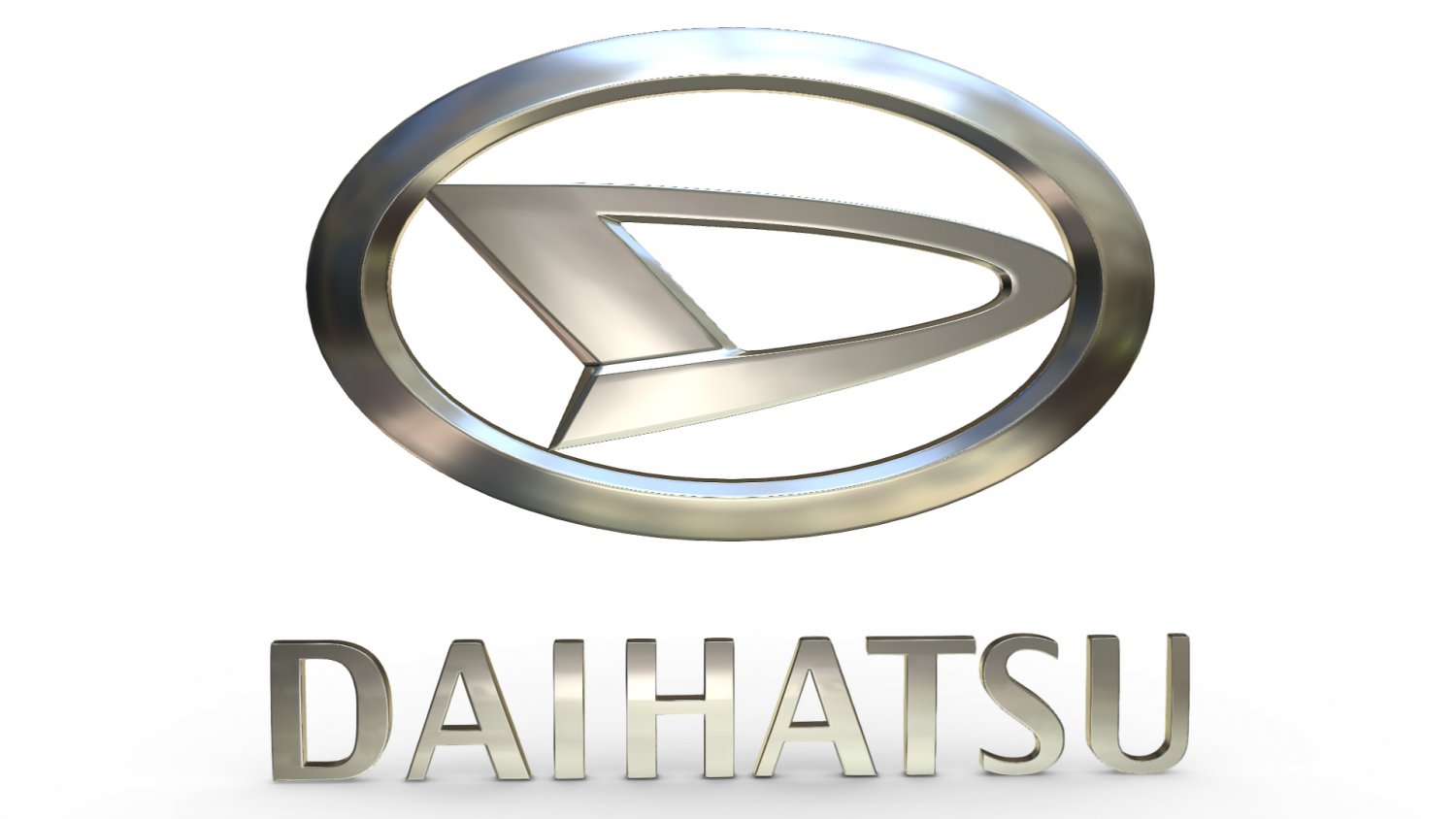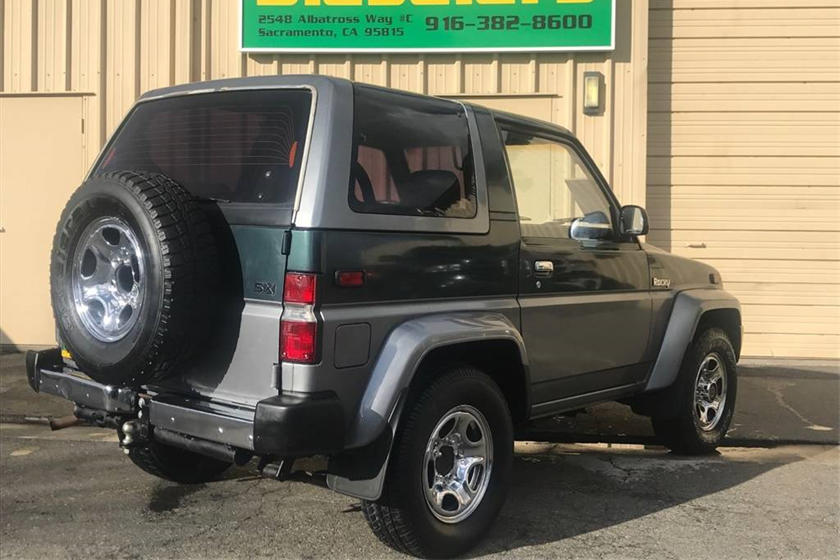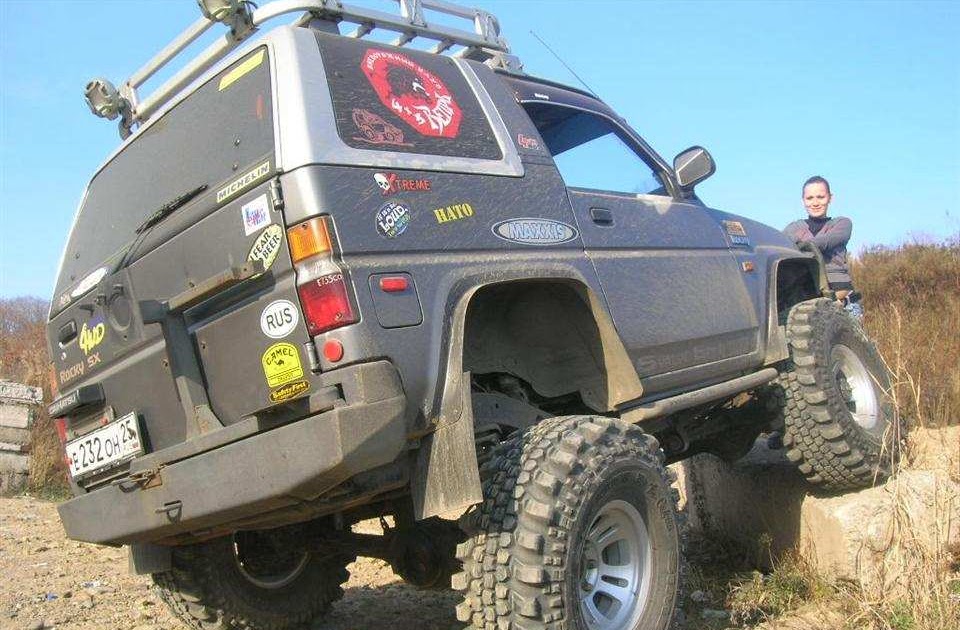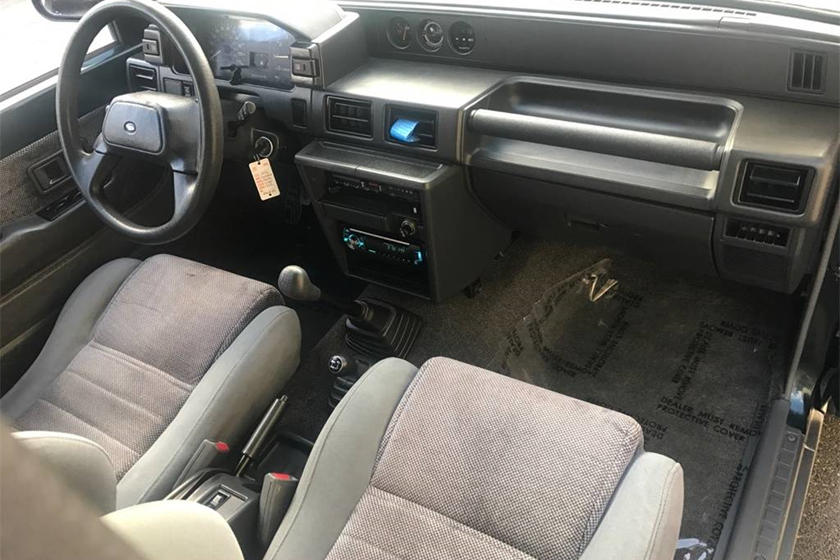mmcartalk
Expert
- Messages
- 4,159
- Reactions
- 2,675
MM Retro-Write-Up: Daihatsu Rocky






http://www.bing.com/videos/search?q=...6C&FORM=VDRVRV
IN A NUTSHELL: Unlike Suzuki’s Samurai, Daihatsu did the American-spec Rocky correctly, but it didn’t sell.
This write-up probably won’t interest a lot of people in the forum, or get many clicks, but, at the time of its U.S. introduction, the Rocky was interesting in that it was not only a competitor to the much-maligned Suzuki Samurai (and later Suzuki Vitara and Sidekick), but substantially safer than the Samurai as well.
Daihatsu, in Japan, was, for years, known as the Master of small-car design, though, of course, never coming close to equalling the sales of such giant firms as Toyota, Honda, or Nissan. In the late 1980s, the company decided to try their hand in the U.S. market. Its first vehicle here, introduced in 1987, was the small cab-over truck-design Hijet, which did not appeal to very many Americans, as there were plenty of other small trucks available, even from Japanese manufacturers, that were somewhat more conventionally-designed. The next year, in 1988, the small subcompact Charade (a 3 or 5-door hatchback/sedan/coupe), and the subcompact Rocky 3-door off-road SUV were introduced. For this write-up, I’ll concentrate on the Rocky. The small Suzuki SUVs, which included the diminutive Samurai and the slightly larger Sidekick/Vitara, were steadily growing more popular, particularly in the GM-branded (and rebadged) Chevrolet/Geo Tracker version, which was available at a lot more dealerships than at Suzuki’s very thin U.S. network. So the Rocky was aimed directly at them….like the Suzukis (and the Jeep Wrangler), the Rocky had a tough ladder-frame, short wheelbase, and excellent approach/breakover/departure angles for tough off-roading.
And, by then, Suzuki had learned its lesson with the Samurai, which was extremely narrow, tall, short, with a terrible center of gravity and classically unstable, and put somewhat more attention into safety with its later models. The Samurai was so diminutive that it could go and fit almost anywhere….if you didn’t flip it over. But, unfortunately, that’s exactly what many people did with it…particularly young, immature kids with little driving-experience, although basic physics and center-of-gravity is taught in most high schools. Consumer Reports gave it a Not-Acceptable rating, and strongly urged people to avoid it. The Samurai soon took the record of piling up more rollover-related lawsuits than any vehicle before it, with the possible exception of early Broncos and Jeeps. Not only was it a classic Flip-Machine, but also very primitive in its design, with the doors held on by fabric straps instead of metal-stops, and an almost complete lack of sound insulation which assaulted your ears. The rock-hard suspension was, over bumps, almost guaranteed to give you a bad back (fortunately, something that most young people don’t have to worry about), the interior was almost like something out of the 1940s, and the vehicle was so small that even the square, space-efficient design didn’t do much for interior room….which wasn’t necessarily a bad thing, because the more proper and cargo you put inside of it, the more unstable you made the handling.
Fortunately, Daihatsu designers saw what was happening with the Samurai, and took some steps to avoid a repeat with the Rocky. First, unlike home-Japanese-market versions of the Rocky, American-spec versions had the very narrow wheel-track widened several inches for better stability and a lower center of gravity. You can tell the American-spec versions from the Japanese from the wider, jutted-out fenders. A fuel-injected 1.6L gasoline in-line four was mated to a 5-speed manual or 4-speed-automatic transmission, in RWD or part-time 4WD format. Better-quality materials, sound-insulation (and real door-hinges) were used inside, though I’d be lying if I said it was anywhere near what we would call an upmarket crossover or SUV today…..the Rocky was still a pretty basic vehicle, reflected in its price, and you certainly wouldn’t confuse it with a Range-Rover. But its wider-track-design paid off…its safety record was substantially better than the Samurai’s….and so were later Suzuki SUVs, for that matter.
The Charade and Rocky appealed to somewhat more Americans than the the first Hijets did, but, even so, Daihatsu never really got off the ground on this side of the Pacific. Company officials, in public, were adamant that they were in the U.S. market to stay. Early TV ads showed a bunch of tall skyscrapers, and then the camera gradually pans down to the street-level, where a Daihatsu Exec keeps shouting to the camera…..”Down Here…..We’re WAY down here”, admitting that they were just a bump on a log in the huge world of Ford, GM. Toyota, etc…. but then claiming that they were going to slog it out and make it here.
Well, despite tough-minded ads, they didn’t make it here….which was perhaps not surprising. I wasn’t a big fan of the Charade, and had more respect for the Rocky….but both were clearly lagging in sales, and, at some point, I guess, Daihatsu management had to fold and accept the fact that it was costing the company more to stay here than they are making. So, after 1992, they packed up and left the American market.
In my area, there was only one Daihatsu dealership that I can remember, in Falls Church, VA (a Washington, DC suburb)…the same shop that had previously sold and serviced Renaults…my brother had bought a Renault 5 (LeCar) from them in 1979. Might have been more, but that’s the only close-by one I can remember, and the clear lack of dealerships, like with Isuzu and Suzuki (and possibly Mitsubishi, although Mitsubishi is still in the American market by a toe) undoubtedly was a factor in the company’s demise. One of my co-workers, at the time, was interested in a Rocky (or, at least, he told me he was), but then, when Daihatsu decided to call it quits here, got a used 1989 Honda Civic CRX SI instead……I did a write-up on that car some time ago.
So, the Rocky joined the large group of what-if vehicles, and we can only guess what would have happened had their makers stayed in the American market or kept them in production. The Rocky did have a number of things going for it, especially after so many people go hurt or killed in Samurais. But it suffered from a lack of name-recognition, the Internet was not yet around to help publicize it, relatively few people even knew of its existence, the sparse dealer-network didn’t help, and by then, the Jeep Cherokee had become extremely popular, the Jeep Wrangler was always popular, Ford and Chevy had smaller/more maneuverable versions of their own Broncos/Blazers, and Suzuki themselves (and their rebadged Chevy/Geo cousins) had better replacements for the Samurai. So, once again, a classic What-If vehicle faded off into the sunset.
And, as Always, Happy Vehicle-Memories.

MM




http://www.bing.com/videos/search?q=...6C&FORM=VDRVRV
IN A NUTSHELL: Unlike Suzuki’s Samurai, Daihatsu did the American-spec Rocky correctly, but it didn’t sell.
This write-up probably won’t interest a lot of people in the forum, or get many clicks, but, at the time of its U.S. introduction, the Rocky was interesting in that it was not only a competitor to the much-maligned Suzuki Samurai (and later Suzuki Vitara and Sidekick), but substantially safer than the Samurai as well.
Daihatsu, in Japan, was, for years, known as the Master of small-car design, though, of course, never coming close to equalling the sales of such giant firms as Toyota, Honda, or Nissan. In the late 1980s, the company decided to try their hand in the U.S. market. Its first vehicle here, introduced in 1987, was the small cab-over truck-design Hijet, which did not appeal to very many Americans, as there were plenty of other small trucks available, even from Japanese manufacturers, that were somewhat more conventionally-designed. The next year, in 1988, the small subcompact Charade (a 3 or 5-door hatchback/sedan/coupe), and the subcompact Rocky 3-door off-road SUV were introduced. For this write-up, I’ll concentrate on the Rocky. The small Suzuki SUVs, which included the diminutive Samurai and the slightly larger Sidekick/Vitara, were steadily growing more popular, particularly in the GM-branded (and rebadged) Chevrolet/Geo Tracker version, which was available at a lot more dealerships than at Suzuki’s very thin U.S. network. So the Rocky was aimed directly at them….like the Suzukis (and the Jeep Wrangler), the Rocky had a tough ladder-frame, short wheelbase, and excellent approach/breakover/departure angles for tough off-roading.
And, by then, Suzuki had learned its lesson with the Samurai, which was extremely narrow, tall, short, with a terrible center of gravity and classically unstable, and put somewhat more attention into safety with its later models. The Samurai was so diminutive that it could go and fit almost anywhere….if you didn’t flip it over. But, unfortunately, that’s exactly what many people did with it…particularly young, immature kids with little driving-experience, although basic physics and center-of-gravity is taught in most high schools. Consumer Reports gave it a Not-Acceptable rating, and strongly urged people to avoid it. The Samurai soon took the record of piling up more rollover-related lawsuits than any vehicle before it, with the possible exception of early Broncos and Jeeps. Not only was it a classic Flip-Machine, but also very primitive in its design, with the doors held on by fabric straps instead of metal-stops, and an almost complete lack of sound insulation which assaulted your ears. The rock-hard suspension was, over bumps, almost guaranteed to give you a bad back (fortunately, something that most young people don’t have to worry about), the interior was almost like something out of the 1940s, and the vehicle was so small that even the square, space-efficient design didn’t do much for interior room….which wasn’t necessarily a bad thing, because the more proper and cargo you put inside of it, the more unstable you made the handling.
Fortunately, Daihatsu designers saw what was happening with the Samurai, and took some steps to avoid a repeat with the Rocky. First, unlike home-Japanese-market versions of the Rocky, American-spec versions had the very narrow wheel-track widened several inches for better stability and a lower center of gravity. You can tell the American-spec versions from the Japanese from the wider, jutted-out fenders. A fuel-injected 1.6L gasoline in-line four was mated to a 5-speed manual or 4-speed-automatic transmission, in RWD or part-time 4WD format. Better-quality materials, sound-insulation (and real door-hinges) were used inside, though I’d be lying if I said it was anywhere near what we would call an upmarket crossover or SUV today…..the Rocky was still a pretty basic vehicle, reflected in its price, and you certainly wouldn’t confuse it with a Range-Rover. But its wider-track-design paid off…its safety record was substantially better than the Samurai’s….and so were later Suzuki SUVs, for that matter.
The Charade and Rocky appealed to somewhat more Americans than the the first Hijets did, but, even so, Daihatsu never really got off the ground on this side of the Pacific. Company officials, in public, were adamant that they were in the U.S. market to stay. Early TV ads showed a bunch of tall skyscrapers, and then the camera gradually pans down to the street-level, where a Daihatsu Exec keeps shouting to the camera…..”Down Here…..We’re WAY down here”, admitting that they were just a bump on a log in the huge world of Ford, GM. Toyota, etc…. but then claiming that they were going to slog it out and make it here.
Well, despite tough-minded ads, they didn’t make it here….which was perhaps not surprising. I wasn’t a big fan of the Charade, and had more respect for the Rocky….but both were clearly lagging in sales, and, at some point, I guess, Daihatsu management had to fold and accept the fact that it was costing the company more to stay here than they are making. So, after 1992, they packed up and left the American market.
In my area, there was only one Daihatsu dealership that I can remember, in Falls Church, VA (a Washington, DC suburb)…the same shop that had previously sold and serviced Renaults…my brother had bought a Renault 5 (LeCar) from them in 1979. Might have been more, but that’s the only close-by one I can remember, and the clear lack of dealerships, like with Isuzu and Suzuki (and possibly Mitsubishi, although Mitsubishi is still in the American market by a toe) undoubtedly was a factor in the company’s demise. One of my co-workers, at the time, was interested in a Rocky (or, at least, he told me he was), but then, when Daihatsu decided to call it quits here, got a used 1989 Honda Civic CRX SI instead……I did a write-up on that car some time ago.
So, the Rocky joined the large group of what-if vehicles, and we can only guess what would have happened had their makers stayed in the American market or kept them in production. The Rocky did have a number of things going for it, especially after so many people go hurt or killed in Samurais. But it suffered from a lack of name-recognition, the Internet was not yet around to help publicize it, relatively few people even knew of its existence, the sparse dealer-network didn’t help, and by then, the Jeep Cherokee had become extremely popular, the Jeep Wrangler was always popular, Ford and Chevy had smaller/more maneuverable versions of their own Broncos/Blazers, and Suzuki themselves (and their rebadged Chevy/Geo cousins) had better replacements for the Samurai. So, once again, a classic What-If vehicle faded off into the sunset.
And, as Always, Happy Vehicle-Memories.

MM
